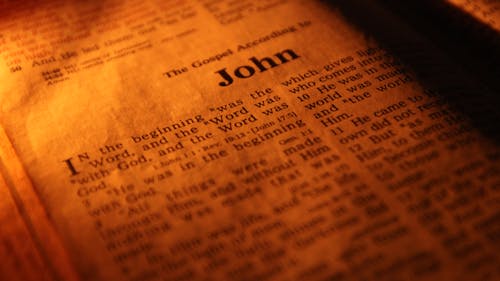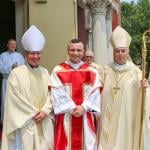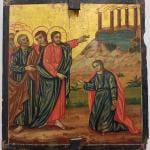The Gospel of John is a treasure to believers in the savior. Though it mentions events that occurred in the synoptics it does so in such a way that the author assumes knowledge of them. However, like the synoptics it was written anonymously[1]. The authorship of the Gospel was attested early in Church history by notable fathers such as Irenaeus[2]. However, with the rise of Liberal theology the authenticy of John the Apostle writing the Gospel has come under question.
Many of these questions of authorship came about in the nineteenth century, and some have continued to the present. This can be seen by prominent New Testament scholars such as Raymond Brown who writes, “As with the other Gospels it is doubted by most scholars that the Gospel was written by an eyewitness of the public ministry of Jesus[3].”
In this article, various theories of authorship will be discussed. A look at individuals such as Bretschneider, Strauss, a theory involving John the Elder, or was the author someone else from the Johannine community? I will show, using historical and well as biblical evidence, that the St. John the Apostle is the likely author.
The Gospel of John and Textual Criticism
In the 19th century there arose a firestorm of sorts when it came to those questioning the authenticity of John[4]. Two of these men were Karl Bretschneider and David Strauss. Bretschneider published a work on the Gospel and discussed reasons why John was not the author. He would later say that he never questioned the authenticity of the Gospel, but questioned it to draw attention to it. David Strauss took a somewhat different view as he not only challenged authorship of the gospel, but also its authenticity[5]. In both cases authenticity was challenged because some of the content was very different than that of the synoptics. In this regard Stephen Barton writes, “The nineteenth century challenge by the likes of Karl Gottlieb Bretschneider and David Friedrich Strauss to the historical reliability of the Gospel, given the marked differences between John and the Synoptics and the characteristically Johannine idiom of the discourses[6].”
In the case of Strauss, he saw the high Christology of John as type of writing called “myth.” For that reason, along with differences with the synoptics, it is the least reliable of the four gospel accounts. In the eyes of Strauss, the true Christ was a divine spirit which lives within all of us, and humanity should be regarded as the true Christ[7]. This brought on the theory that the beloved disciple mentioned in the Gospel in emblematic of all of us. Discussing this Raymond Brown writes, “Some scholars have evaluated the Beloved Disciple as pure symbol, created to model the perfect disciple. That he is never given a name and that he appears alongside Peter in scenes known to us from the Synoptic Gospels where no such figure is mentioned have been invoked as proof of nonhistoricity[8].”

According to Strauss, the stories of Christ’s messiahship, miracles, and divinity were gradually added over time. This can be seen in his work published in 1835 titled Leben Jesu. In this work, he details that the synoptics were part of the oral tradition, but over time expectations of who the Messiah was supposed to be were added[9]. They were added to strengthen the Christian movement, but were so using legend and myth to build up who Christ was. In doing this D.A. Carson writes, “He laid waste to the foundations of historical Christianity[10].” In the views of these two men it was not possible that the author of the Gospel was John the Apostle. To do so would destroy their whole thesis as a historical Christian document. The author was anonymous, or a community of Christians who added legends to the synoptics.
John The Elder as Author?
In his work, Ecclesiastical History, Eusebius distinguishes John the Elder from John the apostle[11]. In that pivotal work Eusebius writes, “Where it is also proper to observe the name of John is twice mentioned, the former of which he mentions with Peter and James and Matthew, and the other apostles; evidently meaning the evangelist. But in a separate point of his discourse he ranks the other John, with the rest not included in the number of apostles, placing Aristion before him: he distinguishes him plainly by the name of presbyter[12].” Per Eusebius, it was John the Elder who wrote the letters of second and third John.
The above quote about the John the Elder goes back to a statement given by the church father Papias. Papias possibly knew John, but we do know that he was a contemporary of Polycarp[13]. The theory of authorship of John the Elder boils down to a couple key points. The first is that there is presumed to be a second John named by Papias. Secondly, Eusebius states that “the Elder” is the author of second and Third John. The language, grammar, and style are very similar to that of First John, and as a result this author may have had some connection to the Gospel of John[14]. Few scholars today hold to the view that John the Elder wrote the Gospel. This is because an examination of the quote from Papias indicates that the term “Elder” and “Apostle” were used interchangeably[15]. Thus, as will be stated later, the quote from Papias will be further evidence for Johannine authorship.
The Johannine Community
Another theory that has gained traction over the past few decades is that of authorship from a Johannine community. This theory insists that traditions from the community were written down over the life of the community[16]. In this case the Johannine community is a community of the Beloved Disciple’s disciples, and generally this theory carries a later date of authorship around A.D. 115[17].

One aspect of this theory that may seem strange to some in the influence of the person named the Beloved Disciple. As Raymond Brown states, “The Beloved disciple was a minor figure during the ministry of Jesus, too unimportant to be remembered in the more official tradition of the synoptics[18].” This author was known to some of the readers of the Gospel, but he chose to keep his identity a mystery[19].
This figure was an important one in the Johannine community, and thus he became the figure in the Gospel of John[20]. In this theory one also must distinguish between the Beloved Disciple and the Evangelist. The Beloved disciple is the source of the Johannine tradition, and the evangelist may have been a disciple of the beloved disciple[21]. In either case, it should not be assumed that one or the other were eyewitnesses to everything described in the Gospel although verse 1:14, 16 say just that. The community may at the teaching of Christ as being received on a spiritual level, rather than physically being an eyewitness[22].
This theory has a few obvious issues that must be addressed. One thing that proponents of it do say is that it does not matter who wrote the Gospel[23]. Authorship is something that is secondary as the message is primary. Most scholars, even if they do not agree with the theory will agree to this. The message is one of redemption and salvation of mankind, but there are still issues with the theory. The theory itself denies the overwhelming internal evidence that speaks for the authorship of John the Apostle. To strengthen the case against the theory here is also extensive external evidence, including testimony from some of the most well-known early church fathers.
Internal Evidence in John’s Gospel
To discover who the author of the Gospel of John is it is wise to look to the Gospel itself. At the beginning of the Gospel the author states, “The Word became flesh and made his dwelling among us. We have seen his glory, the glory from the one and only Son who came from the Father, full of grace and truth[24].” From the onset, there is a clear declaration that the author was also an eyewitness. A study is authorship is aided by John 21:20 and the mention of the Beloved Disciple writing the events down[25].
Thus far there is little differentiated from the Johannine Community theory of authorship. From John 19:26-27 we see that the author is a direct witness to the crucifixion. The three at the foot of the cross were not merely minor characters in the drama of the Messiah, but they were mentioned throughout the Gospel. One of them was Christ’s own mother, Mary. In the passages mention from Chapter nineteen Jesus tell John to “Here is your mother[26].” As previously mentioned a theme in the Johannine community theory of authorship is that the Beloved Disciple was a minor character. If Jesus perfectly fulfilled the law would he relegate the case of his mother to a minor character in his ministry? Not at all because it had to be someone much more important.
From reading the Gospel account that the author is an apostle though he is anonymous. He goes by the description “the one whom Jesus loved.” He is listed among the twelve disciples but is not Bartholomew, Judas Iscariot, Judas the son of James, Thomas, Philip, or Peter. A reading of John 21:2 reveals that he is one of the seven, but “not Peter, Thomas, or Nathaniel[27].” By doing this process of elimination we can deduce that the author is either one of the other disciples listed or the Son of Zebedee[28].
These two individuals can then be compared to listings of the disciples in the synoptic gospels. In regards to this Andreas Kostenberger writes, “Only the following apostles remain: Matthew, Simon the Zealot, James the son of Alphaeus, and John the son of Zebedee[29]”. In regards to Simon the Zealot there is not a shred of evidence from history that associates him as the author of the Gospel. The same can be said of James the son of Alphaeus. Matthew is already credited with the Gospel of Matthew, and that leaves John the son of Zebedee as the likely author.
External Evidence for St. John Being the Author
As there is no shortage on internal evidence there is also no shortage of external evidence for John the Apostle being the author. The early church fathers were basically unanimous in their testimony of Johannine authorship[30]. A quote from Eusebius was previously given in which he used John the Apostle and John the Elder synonymously as the author. In his great work Against Heresies Irenaeus specifically names John the Apostle as the author[31]. The testimony of Irenaeus is to be heard on its own, but it comes with a link to the Apostle himself. Irenaeus was a protégé of Polycarp, who was a direct disciple of the Apostle John[32]. Clement of Alexandria oversaw the famed catechetical school in Alexandria, Egypt also believed the book the be authored by John. To this effect Eusebius writes, “John last of all, composed a spiritual Gospel[33]”.

The great Polycarp is quoted as telling Irenaeus, “John, the disciple of the Lord, who had also leaned upon his breast, had himself published a Gospel during his residence in Ephesus in Asia[34].” As stated previously, Polycarp was taught directly by the Apostle John. It is highly unlikely that he would be creating such a fable in the second century. That, along with the other patristic evidence, points to the authenticity of the Johannine authorship. Other notable church fathers, such as Tertullian, also confirm was stated by Irenaeus and Polycarp[35]. So far the external evidence overwhelmingly supports the conclusion that the Apostle John is the author of the Gospel, but one more piece of evidence will be provided. The early church historian Eusebius also directly names Joh as the author. In his work, Ecclesiastical History Eusebius writes, “They say that John, who during all this time was proclaiming the gospel without writing, at length proceeded to write it on the following occasion[36].
Conclusion
The purpose of this article was to prove that the Gospel of John was written by John the Apostle. Liberal theologians have categorized the Gospel as myth and not historically reliable, but the external evidence proves that theory wrong. A look at the possibility of John the Elder being the author was reviewed, but was determined that Eusebius used terms interchangeably. The theory of a Johannine community authoring the work was looked at, but rejected. It was rejected because the internal evidence shows that the author was not a minor figure, but someone in the inner circle. The internal and external evidence support the idea that John the Apostle authored the Gospel. This was also the belief in the first centuries of the church, and that is highly attested to using writing from the church fathers. The debate may rage on for some scholars, but the evidence is overwhelming. The evidence for John is clear.[37]
Works Cited
[1] D.A. Carson and Douglas J Moo, An Introduction to the New Testament, 2nd ed (Grand Rapids, MI: Zondervan, 2005), 229.
[2] Ibid, 229.
[3] Raymond E. Brown, Introduction to the New Testament (New Haven, CT: Doubleday, 1997), 368-369.
[4] D.A. Carson, The Gospel According to John (Grand Rapids, MI: Eerdmans Publishing, 1991), 30.
[5] Ibid, 30.
[6] Stephen C. Barton, The Gospel of John and Christian Theology (Grand Rapids, MI: Eerdmans Publishing, 2007), 4.
[7] D.A. Carson, The Gospel According to John (Grand Rapids, MI: Eerdmans Publishing, 1991), 30.
[8] Raymond E. Brown, Introduction to the New Testament (New Haven, CT: Doubleday, 1997), 790-791.
[9] H.D. Spence-Jones, The Pulpit Commentary: St. John (New York: NY: Funk and Wagnalls Company, 1909), xiii.
[10] D.A. Carson, The Gospel According to John (Grand Rapids, MI: Eerdmans Publishing, 1991), 30.
[11] J.D. Berry, ed., The Lexham Bible Dictionary (Bellingham, WA: Lexham Press, 2015), John the Elder.
[12] Eusebius, An Ecclesiastical History to the 20th Year of the Reign of Constantine, 142-143rd ed (London: Samuel Bagster & Sons, 1847).
[13] Thomas D. Lea and David Alan Black, The New Testament: Its Background and Message (Nashville, TN: B&h Academic, 2003), 156.
[14] John W. Drane, Introducing the New Testament (Oxford: Lion Publishing, 2000), 457.
[15] Thomas D. Lea and David Alan Black, The New Testament: Its Background and Message (Nashville, TN: B&h Academic, 2003), 156.
[16] Raymond E Brown, Joseph A Fitzmeyer, and Roland E Murphy, eds., The New Jerome Biblical Commentary (Englewood Cliffs, NJ: Prentice Hall, 1990), 946.
[17] Robert J Utley, The Beloved Disciple’s Memoirs and Letters: The Gospel of John, I, II, and II John (Marshall, TX: Bible Lessons International, 1999), 2.
[18] Raymond E. Brown, Introduction to the New Testament (New Haven, CT: Doubleday, 1997), 790-791.
[19] Ruth Edwards, Discovering John (London: Society For Promoting Christian Knowledge, 2003), 26.
[20] Raymond E Brown, An Introduction To The Gospel of John (New York, NY: Doubleday, 2003), 191.
[21] Raymond E. Brown, Introduction to the New Testament (New Haven, CT: Doubleday, 1997), 369.
[22] Ruth Edwards, Discovering John (London: Society For Promoting Christian Knowledge, 2003), 27.
[23] Stephen K. Ray, St. John’s Gospel: A Bible Study Guide and Commentary (San Francisco: CA: Ignatius Press, 2003), 29.
[24] John 1:14 (New International Version).
[25] Andreas J. Kostenberger, Encountering John, 2nd ed (Grand Rapids, MI: Baker Academic, 2013), 4.
[26] John 19:27 (New International Version).
[27] Andreas J. Kostenberger, Encountering John, 2nd ed (Grand Rapids, MI: Baker Academic, 2013), 5.
[28] Ibid, 5.
[29] Ibid, 5.
[30] Stephen K. Ray, St. John’s Gospel: A Bible Study Guide and Commentary (San Francisco: CA: Ignatius Press, 2003), 29.
[31] Alexander Roberts, James Donaldson, and A. Cleveland Coxe, eds., The Apostolic Fathers with Justin Martyr and Irenaeus, vol. 1 The Anti-Nicene Fathers ed (Buffalo: NY: Christian Literature Company, 1885), 328.
[32] D.A. Carson and Douglas J Moo, An Introduction to the New Testament, 2nd ed (Grand Rapids, MI: Zondervan, 2005), 232.
[33] Andreas J. Kostenberger, Encountering John, 2nd ed (Grand Rapids, MI: Baker Academic, 2013), 7.
[34] Alexander Roberts, James Donaldson, and A. Cleveland Coxe, eds., The Apostolic Fathers with Justin Martyr and Irenaeus, vol. 1 The Anti-Nicene Fathers ed (Buffalo: NY: Christian Literature Company, 1885), 414.
[35] John F Wolvoord and Roy B. Zuck, The Bible Knowledge Commentary (Wheaton, IL: Victor Books, 1985), 266.
[36] Eusebius, An Ecclesiastical History to the 20th Year of the Reign of Constantine, 142-143rd ed (London: Samuel Bagster & Sons, 1847), 126.
[37] Paul Enns, The Moody Handbook of Theology (Chicago, IL: Moody Publishers, 2014), 138.













